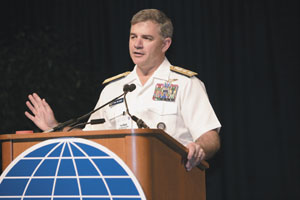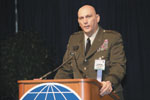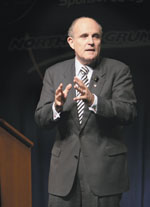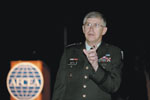Experts Discuss Need for Speed in Communications, Acquisition
 |
| Rear Adm. Thomas E. Zelibor, USN, is the director of global operations, U.S. Strategic Command. |
Homeland defense initiatives and the global war on terrorism are reshaping the strategies and operational methods of militaries around the world, and communications connectivity is the still-evolving enabler driving many of these changes. U.S. Defense Department leaders believe that the powerful capabilities enabled by network centricity are already blurring the lines between the strategic, operational and tactical levels. However, although network centricity offers a multitude of benefits, many challenges lie ahead.
Experts with hands-on experience shared their views at the plenary sessions at TechNet International 2005, which took place May 17-19 at the Washington Convention Center, Washington, D.C. They agreed that network centricity has been essential in military operations during the past several years but added that a long road lies ahead as the military strives to both share and protect more information. TechNet attendees heard in-depth views that centered on the conference’s theme, Network Centric Operations: Balancing Speed and Agility with Security.
Rear Adm. Thomas E. Zelibor, USN, led off the event by pointing out that network-centric warfare is about more than just passing more data faster. Adm. Zelibor, who is the director of global operations, U.S. Strategic Command, emphasized that in practice what is required is the capability to push specific information to commanders. Although information security is important, the military must be careful not to instate so much protection that the information flow slows, making it ineffective. “In security, we need more of a Kevlar vest than full body armor,” he stated.
A balance is required between the need to know, the need to share and the right to know, Adm. Zelibor explained, and this balance must extend to how information is shared both inside and outside the services. In addition to cooperating with other nations, operational personnel must embrace the interdependence of the military, industry and government agencies. These entities must know each other’s thinking and actions so well that they can act as one unit, he noted.
Network-centric warfare is about more than just posting PowerPoint presentations on the Web; it requires systems interoperability, the admiral said. Rather than offering the military complete solutions, industry should supply the tools the services need to create solutions themselves, he added, and simplicity and price are key. “The Holy Grail is an idea, not a machine,” Adm. Zelibor stated.
The admiral proposed that the command and control (C2) acquisition paradigm be changed to resemble the space initiatives business model currently being adopted. Instead of building large, expensive systems that take years to develop and often are obsolete soon after fielding, C2 acquisition processes should support spiral development. The strategic planning cycle, which can affect acquisition, also is definitely too slow today, he added.
During his presentation on Tuesday afternoon, Lt. Gen. Raymond T. Odierno,
Gen. Odierno enumerated the benefits of network centricity. Providing warfighters and decision makers with information empowers them with an understanding of enemies and their cultures, he said. However, network centricity is blurring the lines between the strategic and tactical environments, and new concepts must take this into consideration. From an operational standpoint, integrated mission planning and execution means that operations supported by information sharing can be seamless. In addition, the need for rapid troop deployment requires the ability to share information while on the move.
The nature of today’s adversaries demands a holistic approach to warfare, the general stated. Warfighters must be able to employ lethal, nonlethal and effects-based methods in combat and at the same time work with humanitarian aid organizations to achieve their goals. “There is no sole military solution, so we have to be able to communicate,” he noted.
The general stated that technologies that support Blue Force Tracking and the common operational picture as well as capabilities such as the Joint Tactical Radio System need to be created correctly and immediately. Transformational elements such as the U.S. Army’s modular forces need to be able to communicate across the spectrum. “It can’t be a pickup team. We can’t wait. We need it now,” Gen. Odierno stated.
Speaking directly to representatives from industry in the audience, the general noted that their customers’ cultures are changing, which poses some challenges. First, the Defense Department is not yet properly structured to address all the changes that are taking place. Second, the military is having a difficult time keeping up with all the changes in technology. Finally, the armed services are confronting not only technical but also cultural challenges.
Wednesday’s activities began with a speech by Rudy Giuliani, former mayor of
During his presentation, Giuliani listed the attributes of a good leader detailed in his 2002 book, Leadership. First, a good leader must determine a set of beliefs that are rooted in the future. These are the ideas around which leadership revolves, he said.
In addition, leaders must be optimists, he stated. He elicited laughter from the audience when he illustrated this point. People are not likely to support someone who says, “Things are bad. Things are going to get worse. Now, follow me,” he stated. Along the same lines, leaders must train themselves not only to identify problems but also to offer solutions. Unfortunately, Giuliani pointed out, this technique is effective for people with evil intentions as well.
Having a set of ethical standards is another principle of leadership, he said. Using a sports analogy, Giuliani pointed out that what makes winning a game significant is that the players operate within a certain set of rules. Leaders must set an example by following the rules themselves and ensuring that the people within an organization comply with the standards.
Another important characteristic for leaders is courage. Giuliani emphasized that courage is not a lack of fear but rather the ability to control, manage and overcome fear. One way to accomplish this is by reducing risks, and another is through training. “Are we afraid of another terrorist attack? Yes. But what do we do with that fear? We use it like firefighters use fear—to train better, prepare better and understand better,” he stated. It is especially important to maintain this mindset as the terrorist attacks of September 11 move farther into the past, the former mayor advised.
Related to this attribute is the need to prepare relentlessly. “If you run an organization, get the organization ready for the worst thing that could happen. Be prepared all you can. Anticipate. Something unanticipated will always happen, but if you’ve prepared, your organization will be able to handle it,” he stated. Using the terrorist attacks as an example, Giuliani allowed that, although
Giuliani stressed that valuing individuals leads to teamwork, which is an important asset in every organization. “To believe you were put in charge of a group by God is a big mistake. The first best question you can ask yourself is ‘what are my weaknesses?’ If you can find someone [in the organization] who can balance that, you’ve made the entire team better,” he noted.
Finally, good communication skills and concern for people are central to good leadership, Giuliani stated. It is especially important to support people when they are in trouble or distress, he said, because then they will be more likely to lend their assistance when the leader needs it most.
On Wednesday afternoon, Gen. Benjamin S. Griffin, USA, commanding general, U.S. Army Materiel Command (AMC), spoke to the TechNet audience about both the command’s activities and its needs. He emphasized that, although work takes place at Army facilities, the AMC is truly a joint effort, servicing vehicles from all the forces. This jointness has been helpful in reducing redundancies, he said.
The general also talked about the joint network architecture, which comprises several elements including bandwidth, on-the-move communications, technical standards, and horizontal and vertical information sharing. In terms of bandwidth, Gen. Griffin admitted that although available bandwidth has increased, there will never be enough so perhaps the services need to take a “bandwidth appetite suppressant.”
Among the requirements Gen. Griffin itemized for the future were information security, satellite communications alternatives, bandwidth optimization approaches and joint interoperability. In addition, the military must find ways to increase the speed at which capabilities get into the field. To support this effort, the AMC has instituted a feedback mechanism that allows companies to send information to the command about solutions. In some instances, the response has been good; however, the general adds that there is still room for improvement in this area. The Army Test and Evaluation Command also needs to be faster, more agile and less bureaucratic, he said.
Responding to questions and comments from the audience, Gen. Griffin acknowledged that the command needs and wants to know when warfighters are having difficulties either with equipment or in obtaining equipment, but this is often a problem. “I’d say that 90 percent of the problems we have are communications, and I’m not talking about command and control. We need to know when there are problems out there,” he stated.
One of the challenges the AMC faces, the general stated, is spending the supplemental funds wisely. Industry is helping the command understand how to be more efficient, he said.
Photography by Mike Carpenter
Web Resources
TechNet International 2005: www.technet2005.org
TechNet International 2005 coverage: www.afcea.org/signal/technet_coverage.asp
 | Lt. Gen. Raymond T. Odierno, USA, is the assistant to the chairman, Joint Chiefs of Staff. |
 | Rudy Giuliani is the former mayor of New York City. |
 | Gen. Benjamin S. Griffin, USA, is the commanding general, U.S. Army Materiel Command. |




Comments